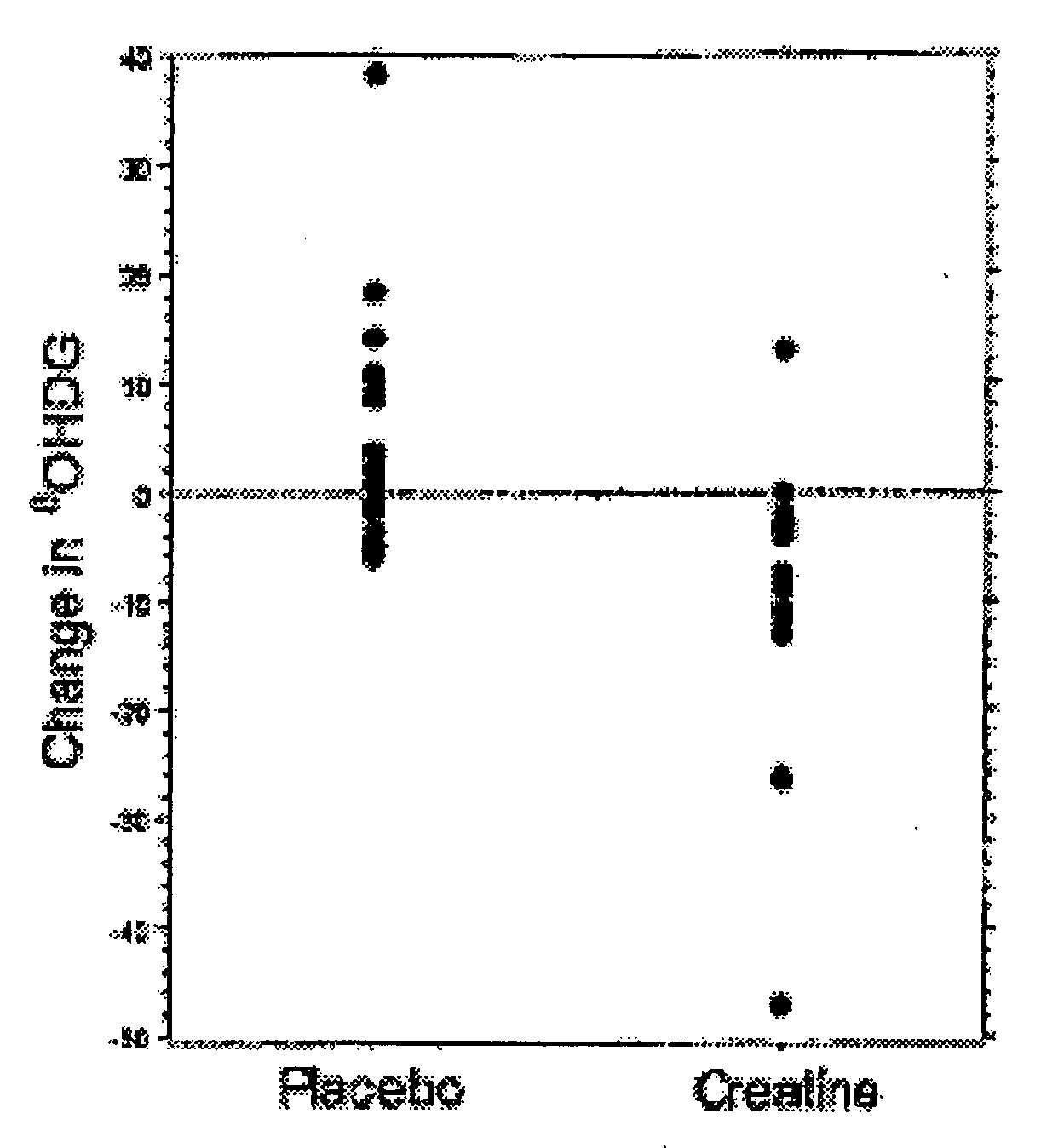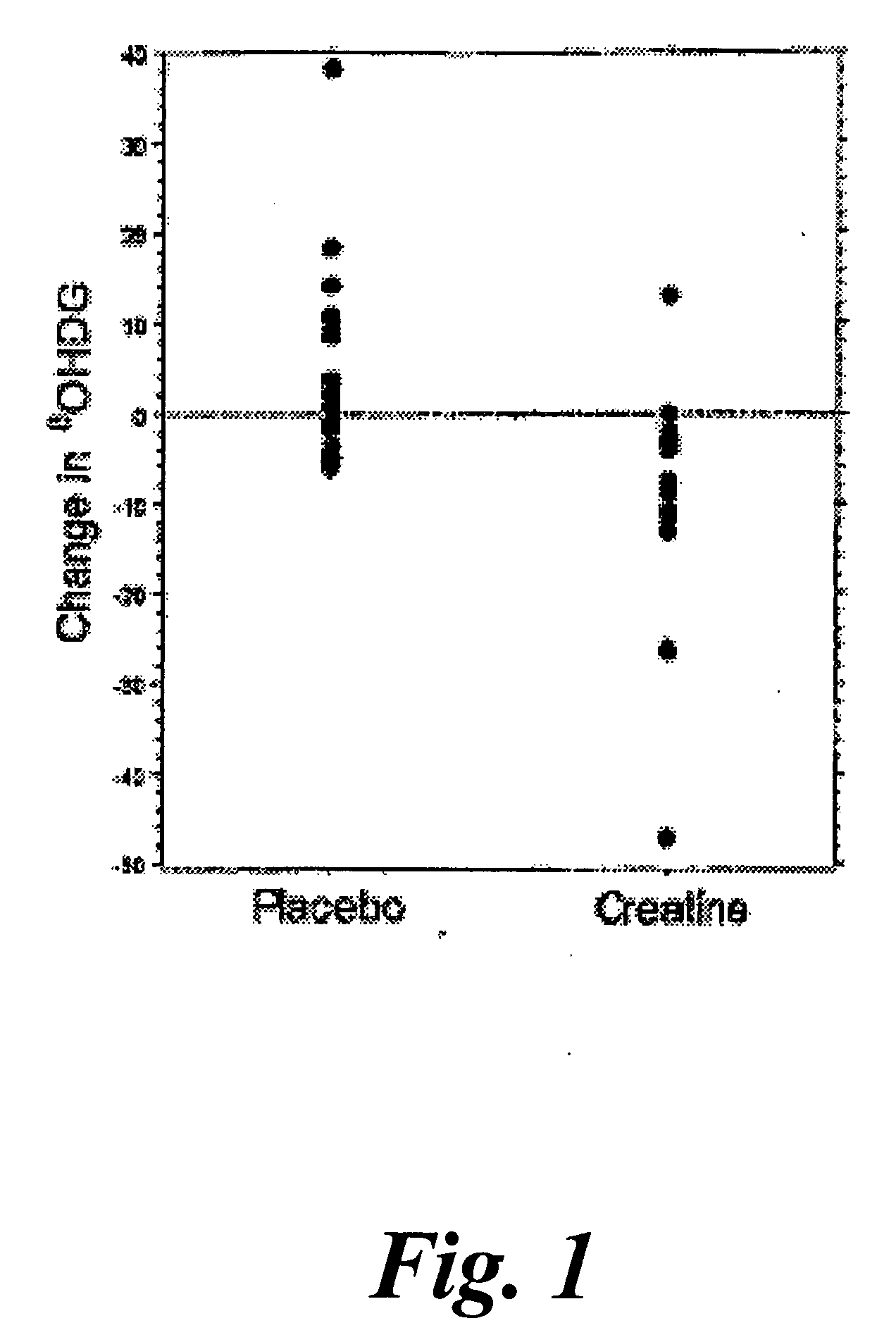Methods of treating a neurological disorder with creatine monohydrate
a neurological disorder and creatine monohydrate technology, applied in the direction of biocide, drug composition, peptide/protein ingredients, etc., can solve the problems of brain inability to initiate or control muscle movement, patients suffering a variety of symptoms, and patients are completely paralyzed and their muscles atrophy, so as to improve the level of 8oh2′dg, the effect of reducing oxidative injury and well tolerated
- Summary
- Abstract
- Description
- Claims
- Application Information
AI Technical Summary
Benefits of technology
Problems solved by technology
Method used
Image
Examples
example 1
Effect of Creatine Monohydrate on Huntington's Disease
[0073] Methods
[0074] Study design. Sixty-four subjects were enrolled at four sites. Eligible subjects were randomized to 8 g / day of creatine monohydrate or placebo by computer-generated blocked randomization with site stratification. Treatment was administered as chewable wafers twice daily for 16 weeks. A medical monitor and independent safety committee reviewed clinical data monthly. Consent, study procedures, and case report forms were approved by the institutional review board at each site. Blood samples for analysis of serum biomarkers were obtained with consent from 30 age-appropriate individuals without neurological illnesses.
[0075] Eligibility criteria. Eligible subjects were 18 years of age and older with a diagnosis of Huntington's disease confirmed by genetic testing, a total functional capacity score of ≧5, and a caregiver to witness consent and monitor compliance. Exclusion criteria included previous creatine expo...
example 2
Randomized, Double-Blind, Clinical Trial on Creatine and Minocycline in Early Parkinson's Disease (PD)
[0086] Methods
[0087] Study Design and Randomization. This example was a single arm futility study designed to assess creatine and minocycline. A placebo arm for calibration was included in the example. Eligible subjects were randomly assigned in a 1:1:1 fashion to receive 1) 10 g / day of creatine monohydrate and placebo minocycline, 2) placebo creatine monohydrate and 200 mg / day of minocycline, or 3) placebo creatine monohydrate and placebo minocycline. The primary futility analysis was at 12 months of follow-up, but each subject was followed for 18 months for additional safety information. Subjects and investigators were kept blinded to treatment group.
[0088] Participants. Subjects were men and women age 30 and over who had a diagnosis of PD but did not require medications for the management of their symptoms. Two of the three cardinal manifestations of PD (tremor, rigidity, and ...
example 3
High-Dose Creatine in Symptomatic Huntington's Disease
[0106] A two-phase open-label study was conducted to better determine an optimal dose of creatine symptomatic subjects with Huntington's disease. A dose-escalation study (10-40 grams per day) was conducted to determine the maximally tolerated dose (MTD) followed by a de-escalation phase to assess whether brain and serum levels of creatine might be maximal at doses lower than the MTD. Ten subjects were enrolled and followed prospectively for two weeks at each done level increasing in 5-gram increments during dose escalation that lasted 13 weeks. Assessments at each visit included UHDRS, EKG, vital signs, clinical safety and research labs. MRI spectroscopy was conducted prior to baseline at peak done (40 grams) and one month after de-escalation to either 30 or 15 grams daily. To determine an optimal dose, pharmacokinetic as well as clinical data were considered. Once the maximal dose was reached, subjects were assigned one of two ...
PUM
| Property | Measurement | Unit |
|---|---|---|
| particle size | aaaaa | aaaaa |
| particle size | aaaaa | aaaaa |
| particle size | aaaaa | aaaaa |
Abstract
Description
Claims
Application Information
 Login to View More
Login to View More - R&D
- Intellectual Property
- Life Sciences
- Materials
- Tech Scout
- Unparalleled Data Quality
- Higher Quality Content
- 60% Fewer Hallucinations
Browse by: Latest US Patents, China's latest patents, Technical Efficacy Thesaurus, Application Domain, Technology Topic, Popular Technical Reports.
© 2025 PatSnap. All rights reserved.Legal|Privacy policy|Modern Slavery Act Transparency Statement|Sitemap|About US| Contact US: help@patsnap.com



